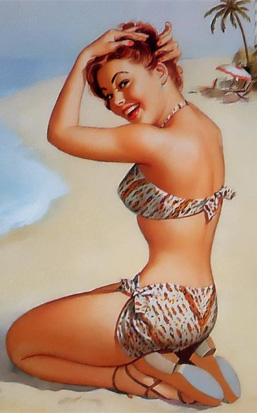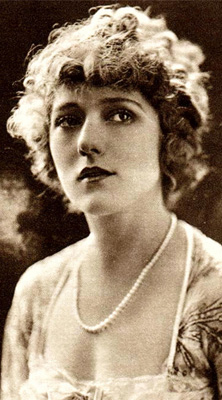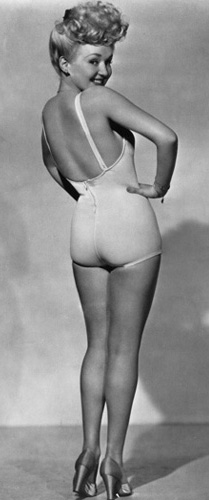Modern Pin-up Art
The modern antecedents of the pin-up can be traced to the Gibson
Girl in America, who made her debut in 1887, and the Art Nouveau posters of
Alphonso Mucha and Jules Cheret in Europe. The prototypical pin-up postcard
artist of the nineteenth century, Raphael Kirchner, contributed to the
establishment of the "pretty girl" format. Also becoming publicly
acceptable was such mainstream popular art as 'Psyche at Nature's Mirror' by
Paul Thumann, first seen in Munsey's December 1893 Issue. White Rock beverages then adopted it as their trademark and, by 1947, the
demure Psyche was attending parties topless! Two popular Glamour icons to
follow the Gibson Girl, were those of Howard Chandler Christy and Harrison
Fisher.
At the turn of the century, the calendar was the most prominent
form of pin-up material, especially the early "glamour girl" formats
by Angelo Asti. In 1913 the controversial nude 'September Morn' by Paul Chabas
was censored by the New York Society for the Supression of Vice. Still, the
image was subsequently printed on literally hundreds of thousands of calendars,
in addition to candy boxes, postcards and more. The Art Deco period also made
respectable any art featuring Romantic nudity, such as that of Mabel Rollins
Harris, Maxfield Parrish and Hy Hintermeister
 By the 1920s,
the golden age of illustration was in full flower. The new film industry fueled
the public's appetite for magazines devoted to their celluloid heroes. In the
1800s, a glimpse of a woman's bare ankle could be considered scandalous.
Compare that with the blatantly sexual girls of the Roaring Twenties by Enoch
Bolles, George Quintana and Earle K. Bergey just a generation later!
Corporations and advertising agencies were likewise vying for the services of
talented artists to create identities the public would respond to. A
significant pre-war American advertising icon was the Arrow Shirt man,
portrayed brilliantly by J.C. Leyendecker. Although Leyendecker is primarily
known for his depictions of men, he had a profound influence upon popular
illustrators such as Norman Rockwell and many who followed.
By the 1920s,
the golden age of illustration was in full flower. The new film industry fueled
the public's appetite for magazines devoted to their celluloid heroes. In the
1800s, a glimpse of a woman's bare ankle could be considered scandalous.
Compare that with the blatantly sexual girls of the Roaring Twenties by Enoch
Bolles, George Quintana and Earle K. Bergey just a generation later!
Corporations and advertising agencies were likewise vying for the services of
talented artists to create identities the public would respond to. A
significant pre-war American advertising icon was the Arrow Shirt man,
portrayed brilliantly by J.C. Leyendecker. Although Leyendecker is primarily
known for his depictions of men, he had a profound influence upon popular
illustrators such as Norman Rockwell and many who followed.
As popular culture devoured its
forbidden voyeuristic fantasies in pulp magazines, and later paperback books,
another trend had begun to legitimize the pin-up as a serious art form: Higher
brow fare offered by such slick periodicals as Esquire (an important
predecessor of Playboy), Cosmopolitan, The Saturday Evening Post and others.
Art Deco depictions of the female form were considered tasteful enough for
inclusion in these magazines. Alberto Vargas makes for a convenient figure as
we watch his style evolve from coy to more explicit. The fact that he started
at Esquire and ended up at Playboy also makes for a barometer of trends within
pin-up.
While Vargas was refining the
centerfold concept, a contemporary of his was pursuing an even higher profile
venue - that of superstar commercial artist. George Petty had worked for
Esquire (Vargas replaced him after a dispute over salary), but the 'Petty Girl'
was a fixture from the 1930s until the 1950s. The Petty Girl pitched a dizzying
array of products to a national audience. She became so firmly entrenched in
the public's consciousness that a movie was actually made about her - a
fictitious airbrushed icon.
During World
War Two, pin-ups accompanied G.I.s in the form of movie star photos like Betty
Grable and Rita Hayworth. Vargas pin-ups were also very much in evidence in the
barracks and as nose-art of the Airforce. Additionally, the Louis F. Dow
Calendar Company produced special booklets of pin-up art created by their star
artist Gillette Elvgren to be mailed overseas. Check out the Collector's Press
Military Pin-Up Kits for example.
After the war, Christian Dior
introduced his 'new look', war restrictions on luxury items such as nylons were
lifted and undergarments finally made the transition to two separate pieces,
the bra and the girdle. Society had moved past the androgynous flappers and the
economically depressed 1930s to a new age of prosperity. The move towards
commercialization was well under way. If a pretty, wholesome girl-next-door
could be utilized to sell a product, why not a girl in stockings modestly
flashing some skin (But she's always a 'good girl' - Its not her fault that
playful puppy pulled her skirt over her head!). If anyone is responsible for
the explosion of vibrant beautiful pitchwomen, it is Chicago artist Haddon
Sundblom.
 Sundblom's lush oil technique
influenced a roster of important pin-up artists. The most famous pupil was Gil
Elvgren, who worked at Sundblom's Stevens-Gross advertising agency along with
such notable artisans as Al Buell, Harry Ekman, Bill Medcalf and Joyce
Ballantyne. Their technique of using thick layers of paint to achieve a warmth
and glow was dubbed 'the mayonnaise school'. Other descendants of this style of
luminous illustration included Donald 'Rusty' Rust, Art Frahm, Peter Driben,
Edward D'Ancona, Edward Runci, Vaughan Alden Bass, Al Brule and Pearl Frush.
Sundblom's lush oil technique
influenced a roster of important pin-up artists. The most famous pupil was Gil
Elvgren, who worked at Sundblom's Stevens-Gross advertising agency along with
such notable artisans as Al Buell, Harry Ekman, Bill Medcalf and Joyce
Ballantyne. Their technique of using thick layers of paint to achieve a warmth
and glow was dubbed 'the mayonnaise school'. Other descendants of this style of
luminous illustration included Donald 'Rusty' Rust, Art Frahm, Peter Driben,
Edward D'Ancona, Edward Runci, Vaughan Alden Bass, Al Brule and Pearl Frush.
Independent of
the national accounts for specific products and services, there were other
fertile markets for pin-up art. Brown & Bigelow, for example, consider
themselves in the 'rememberance advertising' business. They produce office
supplies, playing cards and calendars, many of which are designed to be
imprinted by small companies and then given away as promotions. They employed
some of the best talent to design both generic and industry-specific artwork.
Although they, as well as other calendar publishers, occasionally produced nude
or 'racy' product, they sought not to alienate their conservative or religious
customers with such fare.
Brown & Bigelow also supported several styles of pin-up. In addition to the strait-forward realistic oil paintings of Elvgren and others, they also utilized pastel artists, such as Rolf Armstrong, Earl Moran, Billy de Vorss and Zoe Mozert and originated the 'sketch book' genre pioneered by Earl MacPherson and used to great success by Ballantyne, T.N. Thompson, Fritz Willis, K.O. Munson, Freeman Elliot, Ted Withers and others.
Playboy created a sensation with their centerfold of Marilyn Monroe in 1953. Until that time, it was primarily Esquire who provided opportunities for a generation of pin-up artists, including Ben-Hur Baz, Ernest Chiriaka, Mike Ludlow and J. Frederick Smith. Although Esquire had presented photographic pinups previously, they never contained overt nudity.
An interesting footnote to the Pop Art movement of the 1960's is the work of Mel Ramos, who combined nude pin-ups with recognizable corporate images for a satiric blend of cheesecake and commercialism. Another modern artist of mention is Patrick Nagel, who died tragically early in his promising career. Although Nagel's work has the cool aesthetic of woodblocks and don't invite the viewer into a realistic depiction, the fact that his original paintings, and that of his modern contemporaries, commands incredible prices speaks to the current attitudes towardsthe subject of pin-up as a modern art form.


The
introduction of explicit men's magazines (Penthouse introduced the world to
pubic hair in 1970) made such innocent depictions seem quaint and
old-fashioned. Photography was a quick and easy means to satisfy the pressures
of monthly deadlines. Today's sex symbols seem to be comprised of pre-packaged
teen sensations, silicone-enhanced quasi porn stars and anorexic 'supermodels'.
Modern pin-up artists such as Olivia de Berardinis, Hajime Sorayama, Carlos
Cartagena, Jennifer Janesko, Alain Aslan and John Kacere have turned their
vision towards photorealistic fantasy or fetishistic subjects and lack the
innocence of their predecessors. (Many also tend to specialize in airbrush, a
technique that can leave a cold, hard and artificial look.)
Still there are those, such as Dave
Stevens, who have not forgotten how to draw a good girl in a bad situation
without showing us every anatomical detail of his subjects. We must thank Dave,
not only for creating the Rocketeer character, but for reviving interest in the
great photo pin-up gal of the 1950s, Bettie Page. I am also particularly fond
of some modern European illustrators such as Milo Manara. (There's also Eric
Stanton, who provided us with bad girls in bad situations, but that is the
opposite direction of cheesecake!) To draw the line arbitrarily, I have created
a page specifically for another interest of mine, comics. Although Stevens,
Greg Hildebrandt, Jay Pike, Bill Ward and others have experience in the comic
world (Which includes the sub-genres of 'good girl', 'bad girl', superheroine
and Anime), their depictions continue to expand my precepts of successful
pin-up art and are documented elsewhere.
Pin-Up
Artists:
Addams, Lara
Armstrong, Rolf

Ballantyne, Joyce
Ballantyne, Joyce
Blanton, Mark
Bolles, Enoch
Brule, Al
Chiriaka, Ernest
D'Ancona, Edward
Driben, Peter
Ekman, Harry
Elvgren, Gil
Erbit, Jules
Harrison, Fisher
Henslee, Jack
Hildebrandt, Greg
Janesko, Jennifer
Kacere, John
Layne, Bill
Jerry von Lind
Medcalf, Bill
Meunier, Susanne
Moran, Earl
Mozert, Zoe
Munson, K.O.
Pearl, Frush
Petty, George
Ramos, Meir
Randall, Bill
Runci, Edward
Sarger, Xavier
Sorayama, Hajime
Thompson, T.N.
Vargas, Alberto
Billy de Vorss
Willis, Fritz
Withers,
Ted









.jpg)












.jpg)








